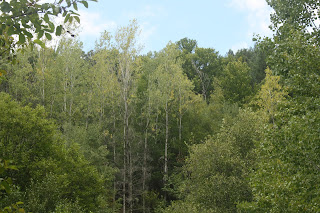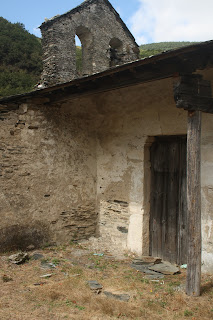The Hills to the East
 In eastern Galicia, where this region meets León, there are mountains that reach 1500 meters, with soaring summits, and plummeting valleys with wild brooks that meander down ravines. There are no commercial pines or eucalyptus planted on their slopes, and the local flora flourishes. Chestnuts, oaks, walnuts, maples, birches, hazles, heather, all kinds of Mediterranean and Atlantic flora, depending on altitude. It's a beautiful, yet rough land, through which there are lanes that in winter snows become impassible, obliging the dwindling residents to be resilient and prepared for isolation.
In eastern Galicia, where this region meets León, there are mountains that reach 1500 meters, with soaring summits, and plummeting valleys with wild brooks that meander down ravines. There are no commercial pines or eucalyptus planted on their slopes, and the local flora flourishes. Chestnuts, oaks, walnuts, maples, birches, hazles, heather, all kinds of Mediterranean and Atlantic flora, depending on altitude. It's a beautiful, yet rough land, through which there are lanes that in winter snows become impassible, obliging the dwindling residents to be resilient and prepared for isolation. The Romans reached this area, and, of course, exploited it. They took iron, gold, and antimony back to the Empire. There are still abandoned mines to be found, including tunnels near the village of Romeor. To get to them, you need to cross the village, and walk just over a kilometer up the mountain. We got to the stepping off point, but it was beginning to rain, we weren't in possession of a flashlight nor proper, waterproofed footwear, so we put it off for another year.
 There are old churches in the villages, some of which look like they haven't had anything done to them since they were built. One, San Pedro de Esperante in the township of Seoane, has an old slate roof, plaster falling off its walls, and doors that look a couple of centuries old. It looks older than our parish church, built in the sixteenth century, but it's actually a hundred years younger. The cemetery is well kept up, though, with slope-roofed niches. The name of the place apparently comes from a Roman called Speranti, who mined for gold at a field nearby where there's a camping site now.
There are old churches in the villages, some of which look like they haven't had anything done to them since they were built. One, San Pedro de Esperante in the township of Seoane, has an old slate roof, plaster falling off its walls, and doors that look a couple of centuries old. It looks older than our parish church, built in the sixteenth century, but it's actually a hundred years younger. The cemetery is well kept up, though, with slope-roofed niches. The name of the place apparently comes from a Roman called Speranti, who mined for gold at a field nearby where there's a camping site now. There's plenty of iron in the hills, too. We re-stumbled upon a smithy that was over two hundred years old. It's in the appropriately named village of Ferrería, near Seoane. (Ferrería means smithy.) The building is made of slate, and is in private hands, though the regional government plans to, at some time in the future, make an ethnographical museum. The smithy has a sign saying, "Gran Ferrería Locay," and is named for the man who came from making a fortune in Cuba in 1918, and bought it as an inversion. He converted it into an electric plant, giving electricity to seven villages, a mill, and a sawmill; and all that using hydraulic power from the river that runs next to it.
 Before that, though, it was a smithy with a past. In 1808, the present building was erected upon a site where a smithy had already existed for many years. It coincided with the Napoleonic wars, and an artillery general, knowledgeable of the smithys of the area, came by to ask a favor. From then until the end of the War of Independence, the smithy made weapons and canons for the insurgents and the British troops. After that, it was sold to a priest, who left it to his family in his will (what vow of poverty?).
Before that, though, it was a smithy with a past. In 1808, the present building was erected upon a site where a smithy had already existed for many years. It coincided with the Napoleonic wars, and an artillery general, knowledgeable of the smithys of the area, came by to ask a favor. From then until the end of the War of Independence, the smithy made weapons and canons for the insurgents and the British troops. After that, it was sold to a priest, who left it to his family in his will (what vow of poverty?). The area is quiet. There is an area next to the river with tables and chairs, where drinks and food are served in the summer. When we were there, it seemed closed. September is no longer summer, it seems. That area and the smithy still belongs to the descendents of the man who bought the smithy and the surrounding land in 1918. The smithy was restored by the regional government in the late 1990's, and was supposed to be open to the public. But differences between the government and the owners meant that it is only open once a year, when the owners have a musical jamboree night at the beginning of August.
 From there we continued to the town on the edge of the regional map, Cebreiro. That town is famous for being the first stop in Galicia for those walking the Way of Santiago. Normally, it is filled with pilgrims stopping over in its pensions and hostels. The town now lives from the business of feeding and housing pilgrims. It also has a miraculous chalice housed in the church. In Spain there are at least two places that lay claim to the Holy Grail. O Cebreiro boasts its own holy chalice. The story goes that around a thousand years ago, there was a priest there who was beginning to doubt the Transubstantiation - the transformation of bread and wine into the body and blood of Jesus. One wintry evening, snow tumbling around and wind whistling, he was preparing for evening Mass in an empty church. As he was beginning the Offertory, the door opened and a pious man arrived. As the man kneeled in his pew, the priest thought, "Poor man, trudging on such a night just to kneel before a piece of bread and a cup of wine." At that moment, the bread turned into a piece of flesh, the wine into blood, and the priest understood he had been wrong. At that moment he fell down, dead, and the chalice and paten were preserved as a remembrance of that miracle.
From there we continued to the town on the edge of the regional map, Cebreiro. That town is famous for being the first stop in Galicia for those walking the Way of Santiago. Normally, it is filled with pilgrims stopping over in its pensions and hostels. The town now lives from the business of feeding and housing pilgrims. It also has a miraculous chalice housed in the church. In Spain there are at least two places that lay claim to the Holy Grail. O Cebreiro boasts its own holy chalice. The story goes that around a thousand years ago, there was a priest there who was beginning to doubt the Transubstantiation - the transformation of bread and wine into the body and blood of Jesus. One wintry evening, snow tumbling around and wind whistling, he was preparing for evening Mass in an empty church. As he was beginning the Offertory, the door opened and a pious man arrived. As the man kneeled in his pew, the priest thought, "Poor man, trudging on such a night just to kneel before a piece of bread and a cup of wine." At that moment, the bread turned into a piece of flesh, the wine into blood, and the priest understood he had been wrong. At that moment he fell down, dead, and the chalice and paten were preserved as a remembrance of that miracle. These hills and valleys have hidden gems and untold stories that would fill volumes. All the greens of the universe are there; stones almost as old, as well. We've been four times, we will return many more.



Comments
Post a Comment